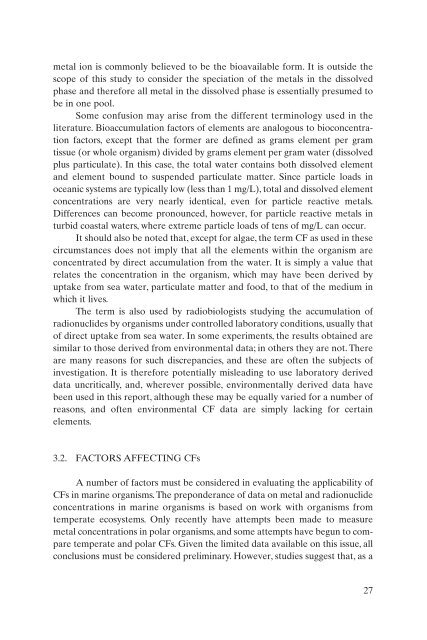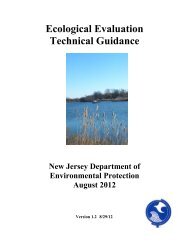Sediment Distribution Coefficients and Concentration Factors for ...
Sediment Distribution Coefficients and Concentration Factors for ...
Sediment Distribution Coefficients and Concentration Factors for ...
Create successful ePaper yourself
Turn your PDF publications into a flip-book with our unique Google optimized e-Paper software.
metal ion is commonly believed to be the bioavailable <strong>for</strong>m. It is outside thescope of this study to consider the speciation of the metals in the dissolvedphase <strong>and</strong> there<strong>for</strong>e all metal in the dissolved phase is essentially presumed tobe in one pool.Some confusion may arise from the different terminology used in theliterature. Bioaccumulation factors of elements are analogous to bioconcentrationfactors, except that the <strong>for</strong>mer are defined as grams element per gramtissue (or whole organism) divided by grams element per gram water (dissolvedplus particulate). In this case, the total water contains both dissolved element<strong>and</strong> element bound to suspended particulate matter. Since particle loads inoceanic systems are typically low (less than 1 mg/L), total <strong>and</strong> dissolved elementconcentrations are very nearly identical, even <strong>for</strong> particle reactive metals.Differences can become pronounced, however, <strong>for</strong> particle reactive metals inturbid coastal waters, where extreme particle loads of tens of mg/L can occur.It should also be noted that, except <strong>for</strong> algae, the term CF as used in thesecircumstances does not imply that all the elements within the organism areconcentrated by direct accumulation from the water. It is simply a value thatrelates the concentration in the organism, which may have been derived byuptake from sea water, particulate matter <strong>and</strong> food, to that of the medium inwhich it lives.The term is also used by radiobiologists studying the accumulation ofradionuclides by organisms under controlled laboratory conditions, usually thatof direct uptake from sea water. In some experiments, the results obtained aresimilar to those derived from environmental data; in others they are not. Thereare many reasons <strong>for</strong> such discrepancies, <strong>and</strong> these are often the subjects ofinvestigation. It is there<strong>for</strong>e potentially misleading to use laboratory deriveddata uncritically, <strong>and</strong>, wherever possible, environmentally derived data havebeen used in this report, although these may be equally varied <strong>for</strong> a number ofreasons, <strong>and</strong> often environmental CF data are simply lacking <strong>for</strong> certainelements.3.2. FACTORS AFFECTING CFsA number of factors must be considered in evaluating the applicability ofCFs in marine organisms. The preponderance of data on metal <strong>and</strong> radionuclideconcentrations in marine organisms is based on work with organisms fromtemperate ecosystems. Only recently have attempts been made to measuremetal concentrations in polar organisms, <strong>and</strong> some attempts have begun to comparetemperate <strong>and</strong> polar CFs. Given the limited data available on this issue, allconclusions must be considered preliminary. However, studies suggest that, as a27
















